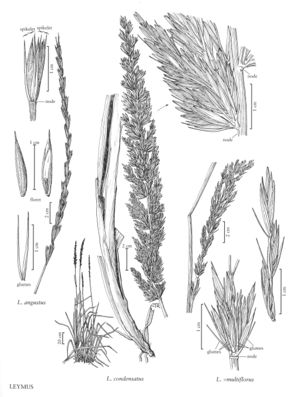Difference between revisions of "Leymus angustus"
FNA>Volume Importer |
imported>Volume Importer |
||
| (8 intermediate revisions by 2 users not shown) | |||
| Line 7: | Line 7: | ||
|synonyms={{Treatment/ID/Synonym | |synonyms={{Treatment/ID/Synonym | ||
|name=Elymus angustus | |name=Elymus angustus | ||
| − | |authority= | + | |authority= |
| + | |rank=species | ||
}} | }} | ||
|hierarchy=Poaceae;Poaceae subfam. Pooideae;Poaceae tribe Triticeae;Leymus;Leymus angustus | |hierarchy=Poaceae;Poaceae subfam. Pooideae;Poaceae tribe Triticeae;Leymus;Leymus angustus | ||
| Line 20: | Line 21: | ||
-->{{Treatment/Body | -->{{Treatment/Body | ||
|distribution=Alta.;B.C.;Sask.;Yukon | |distribution=Alta.;B.C.;Sask.;Yukon | ||
| − | |discussion=<p>Leymus angustus is a Eurasian species that, in its native range, grows in alkaline meadows, and on sand and gravel in river and lake valleys. Several cultivars of L. angustus have been developed for use as forage, particularly in Canada. Some of the better known are 'Prairieland', 'Eejay', and 'Pearl'. The distribution of L. angustus in the Flora region is not known.</p><!-- | + | |discussion=<p><i>Leymus angustus</i> is a Eurasian species that, in its native range, grows in alkaline meadows, and on sand and gravel in river and lake valleys. Several cultivars of <i>L. angustus</i> have been developed for use as forage, particularly in Canada. Some of the better known are 'Prairieland', 'Eejay', and 'Pearl'. The distribution of <i>L. angustus</i> in the Flora region is not known.</p><!-- |
| − | --><p>Chen and Zhu (2006) describe Leymus angustus as always being puberulent. Some accessions cultivated under this name by the U.S. Department of Agriculture (Plant Introduction Numbers 110,079; 406,461), have glabrous, glaucous lemmas and glumes that tend to exceed the lemmas, suggesting that they belong to another taxon, possibly L. karelinii (Turcz.) Tzvelev, a species for which 2n = 56.</p> | + | --><p>Chen and Zhu (2006) describe <i>Leymus angustus</i> as always being puberulent. Some accessions cultivated under this name by the U.S. Department of Agriculture (Plant Introduction Numbers 110,079; 406,461), have glabrous, glaucous lemmas and glumes that tend to exceed the lemmas, suggesting that they belong to another taxon, possibly L. karelinii (Turcz.) Tzvelev, a species for which 2n = 56.</p> |
|tables= | |tables= | ||
|references= | |references= | ||
| Line 30: | Line 31: | ||
-->{{#Taxon: | -->{{#Taxon: | ||
name=Leymus angustus | name=Leymus angustus | ||
| − | |||
|authority=(Trin.) Pilg. | |authority=(Trin.) Pilg. | ||
|rank=species | |rank=species | ||
| Line 37: | Line 37: | ||
|basionyms= | |basionyms= | ||
|family=Poaceae | |family=Poaceae | ||
| + | |illustrator=Cindy Roché | ||
| + | |illustration copyright=Utah State University | ||
|distribution=Alta.;B.C.;Sask.;Yukon | |distribution=Alta.;B.C.;Sask.;Yukon | ||
|reference=None | |reference=None | ||
| Line 42: | Line 44: | ||
|publication year= | |publication year= | ||
|special status= | |special status= | ||
| − | |source xml=https:// | + | |source xml=https://bitbucket.org/aafc-mbb/fna-data-curation/src/200273ad09963decb8fc72550212de541d86569d/coarse_grained_fna_xml/V24/V24_518.xml |
|subfamily=Poaceae subfam. Pooideae | |subfamily=Poaceae subfam. Pooideae | ||
|tribe=Poaceae tribe Triticeae | |tribe=Poaceae tribe Triticeae | ||
Latest revision as of 16:24, 11 May 2021
Plants somewhat cespitose, rhizomatous. Culms 60-120 cm tall, 2.5-7 mm thick, solitary or few together, glabrous or pubescent below the nodes. Leaves exceeded by the spikes, basally concentrated; sheaths smooth, scabridulous, or hairy; auricles to 1 mm; ligules 0.5-1 mm, rounded to obtuse, sometimes erose; blades 15-20 cm long, 5-7 mm wide, glaucous, stiff, involute, abaxial surfaces glabrous or hairy, sometimes scabridulous, adaxial surfaces scabrous, with 7-17 closely spaced subequal veins. Spikes 10-25 cm long, 7-10 mm wide, with 2(3) spikelets per node; internodes 8-10 mm, surfaces strigillose, hairs to 0.3 mm, edges ciliate, cilia to 1 mm. Spikelets 10-19 mm, with 2-3 florets. Glumes 10-13 mm long, 0.5-2.5 mm wide, exceeded by the florets, narrowly lanceolate, tapering from the base, stiff, keeled, the central portion thicker than the margins, (0)1(3)-veined at midlength, bases expanded, overlapping, concealing the base of the lowest floret, scabrous; lemmas 8-13 mm, densely hairy and not glaucous, hairs to 0.4 mm, or glabrous and glaucous, apices unawned or awned, awns to 2.5 mm; anthers 3-4 mm, dehiscent. 2n = 84.
Distribution
Alta., B.C., Sask., Yukon
Discussion
Leymus angustus is a Eurasian species that, in its native range, grows in alkaline meadows, and on sand and gravel in river and lake valleys. Several cultivars of L. angustus have been developed for use as forage, particularly in Canada. Some of the better known are 'Prairieland', 'Eejay', and 'Pearl'. The distribution of L. angustus in the Flora region is not known.
Chen and Zhu (2006) describe Leymus angustus as always being puberulent. Some accessions cultivated under this name by the U.S. Department of Agriculture (Plant Introduction Numbers 110,079; 406,461), have glabrous, glaucous lemmas and glumes that tend to exceed the lemmas, suggesting that they belong to another taxon, possibly L. karelinii (Turcz.) Tzvelev, a species for which 2n = 56.
Selected References
None.
